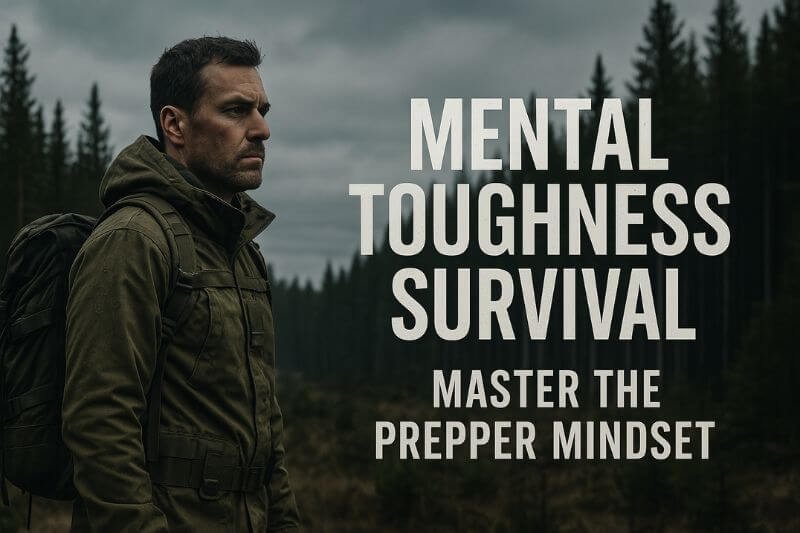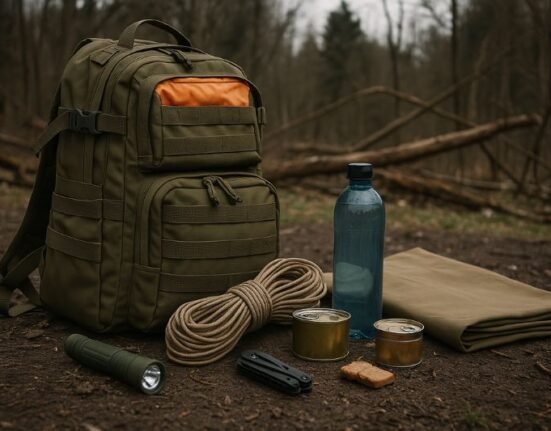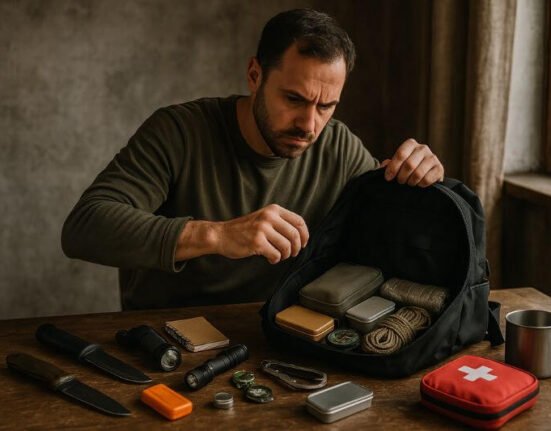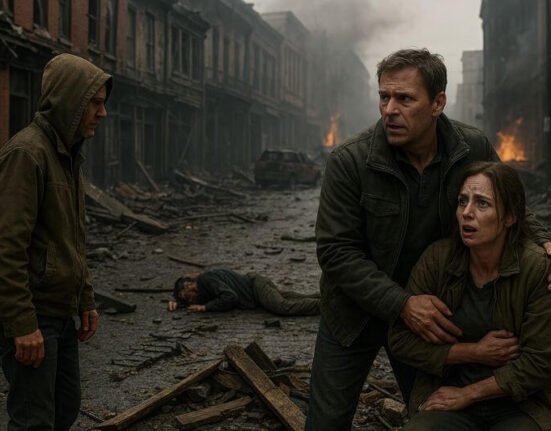Mental toughness survival is the most important skill for any prepper. You can have food, gear, and training — but if your mind collapses, none of it matters. That’s why developing true mental toughness isn’t optional. It’s the foundation of survival.
It’s not about “being strong.” It’s about being mentally trained to stay focused, adaptable, and rational — especially when chaos is loud and options are few.
What mental toughness really means in survival
It’s not about being emotionless. It’s about control. The mentally tough don’t avoid fear — they face it, understand it, and move forward anyway.
In survival, mental toughness is the ability to:
- Stay calm under extreme stress
- Make fast, high-stakes decisions
- Manage fear, pain, and uncertainty
- Maintain hope without illusions
- Keep going when others stop
Forget Hollywood survival scenes. In real collapse, the toughest people are the ones who don’t quit, who think clearly while hungry, tired, scared, and alone.
“Your brain is your first and last tool. Train it harder than your gear.”
— CivilFall Field Manual, 2024 Edition
Why most people fail without mental conditioning
Look at any real-world disaster. Earthquakes, wars, mass blackouts — most people don’t die from lack of resources. They break down mentally.
They freeze. They panic. They argue, collapse, or wait too long. Why? Because they never trained their mind for sustained stress.
FEMA reports that “psychological disorientation” is one of the top causes of preventable fatalities in major urban disasters. That means people simply lose the ability to think.
That’s not weakness. It’s lack of training. And like any skill, it can be built.
What preppers can learn from elite performers
Military operators. Arctic explorers. Prisoners of war. These people survive because of mental training, not just physical ability.
Key principles they apply include:
- Rehearsal of high-risk scenarios
- Acceptance of worst-case outcomes
- Discipline in routine and mindset
- Mental compartmentalization
- Constant internal dialogue
These methods aren’t reserved for special forces. They’re 100% applicable to civilian preppers. We’ll explore how to use them in Part 2.
The difference between mindset and toughness
Mindset is the foundation — how you view the world, risk, control, uncertainty.
Toughness is the ability to act within that mindset, even when things go wrong.
Together, they form the backbone of any prepper’s psychological kit.
| Component | Mindset | Mental Toughness |
|---|---|---|
| Core Focus | Beliefs and orientation | Actions under pressure |
| Purpose | Create clarity and direction | Maintain function in difficulty |
| Goal | Internal alignment | External application in real time |
| Example | “I expect collapse and plan for it” | “I stay focused even when collapse hits” |
Early signs your mental toughness is lacking
Before a real crisis hits, your everyday life shows where you stand.
Common signals of mental fragility:
- You avoid discomfort regularly
- You shut down in heated arguments
- You obsess over perfection before taking action
- You give up quickly when plans break
- You need external validation to move forward
If you recognize yourself here, don’t worry. You’re not weak — just untrained.
Mental toughness isn’t genetic. It’s earned — and we’ll start building it in the next section.
Key takeaway from Part 1
Mental toughness is what allows preppers to endure, lead, and survive when systems fail and reality hits hard.
With it, you become unstoppable — not because you’re fearless, but because you act despite the fear.
Training Mental Toughness Like a Survival Skill
Mental toughness doesn’t come from crisis. It comes from preparation. If you wait until collapse to test your brain, it’s already too late.
Mental resilience is a skill — like first aid or fire-starting. And just like your hands or body, your mind needs stress, recovery, and routine to grow stronger.
Let’s build the drills and habits that shape true mental armor.
Create your survival mindset baseline
Before training, assess where you are. Mental toughness begins with self-awareness — not bravado.
Ask yourself:
- How do I react to sudden change or bad news?
- Can I make fast decisions without overthinking?
- Do I operate well under time pressure?
- How long can I tolerate discomfort before shutting down?
Write down your honest answers in a notebook. This becomes your baseline — the version of you that training will improve.
Build daily habits that reinforce grit
Small, consistent practices matter more than rare extreme experiences. Your daily routine is your mental gym.
Start with these:
- Wake up early — discipline starts with control over time
- Make your bed — first win of the day, no excuses
- Cold showers — train response to discomfort
- Daily physical exercise — movement builds momentum
- Silence or no-input mornings — resist noise, center your mind
None of this requires money or equipment. But done consistently, these shape a brain that can act without delay.
“Routine is the skeleton of mental strength.”
— CivilFall Resilience Guide
Use progressive discomfort to expand your limits
Comfort kills toughness. Every real survivor has learned to operate through discomfort, not around it.
Design weekly challenges that simulate mental pressure.
| Challenge Example | Mental Toughness Benefit |
|---|---|
| 24h fast (water only) | Improves focus and emotional control |
| Sleep outdoors alone | Builds courage and spatial awareness |
| Train in bad weather | Resilience against environment stress |
| No talking for 12 hours | Strengthens inner dialogue and clarity |
| Cold exposure (5–10 mins) | Builds shock response tolerance |
These are not punishment. They’re preparation.
Practice emotional control drills
Fear. Anger. Shame. These destroy survival decision-making if not trained in advance.
Try this drill:
- Sit in silence
- Recall a recent argument or fear
- Let it rise — don’t suppress it
- Describe the emotion in your mind: “I feel fear. It’s tight in my chest. It’s temporary.”
- Breathe into it. 5 seconds in, 5 out.
- End with: “This feeling is not in control. I am.”
The more you train under emotional weight, the more control you have when things get real.
Rehearse crisis scenarios mentally
Elite soldiers rehearse before they deploy. Preppers should too.
Mental rehearsal steps:
- Choose a real threat: house fire, riot, EMP, hostage situation
- Close your eyes and walk through it from the start
- See the sights, feel the sounds, hear the chaos
- Visualize yourself responding: moving, helping, acting
- Open your eyes — write down what felt unclear or weak
Repeat often. With time, your brain learns to stay sharp under pressure — because it’s “been there” already.
Train response speed under time pressure
Panic is slow. Clarity is fast. But it must be trained.
Try the 60-second scenario drill:
- Pick a survival situation (e.g., intruder, gas leak, active shooter)
- Start a 60-second countdown
- Speak aloud: What’s your first move? What gear do you need? Where do you go?
- Reset and change the scenario
This drill forces instinctive action — the opposite of panic.
Strengthen your mind through writing
Use a survival mindset journal to track your growth.
Each evening, write down:
- 1 situation where you overcame discomfort
- 1 emotion you recognized and controlled
- 1 action you took despite hesitation
- 1 lesson learned that day
Journaling creates self-accountability. You stop guessing your progress — you see it.
Push the limit with weekend intensity drills
Once per month, do a high-stress prep test. Simulate:
- A sudden bug-out with 10 minutes prep
- 48h off-grid with limited food
- Navigation without GPS in an unfamiliar area
- 12h without speaking or using a phone
- Long hike with a heavy bag + no music, no distraction
These build your brain’s confidence: “I can suffer — and still think.”
Applying Mental Toughness in Real-World Collapse
Training is theory. Collapse is reality. And the moment systems fail, your mental toughness becomes your most valuable weapon.
Food can spoil. Gear can get lost. Allies can break down. But your mind — if trained — will keep moving forward when everything else stalls.
What happens when mental training is missing
In real disaster zones, mental collapse shows up fast.
During the 2010 Haiti earthquake, rescuers reported survivors frozen in place under rubble — not physically trapped, but mentally paralyzed.
After Hurricane Katrina, some people refused evacuation until it was too late — not out of ignorance, but out of denial.
These aren’t rare cases. They are normal reactions from untrained minds.
Mental toughness isn’t about being “superhuman.” It’s about being functional when pressure breaks everyone else.
Recognizing breakdown before it escalates
Mental collapse doesn’t start with screaming or panic. It starts with subtle behaviors:
- You become indecisive
- You forget obvious steps
- You repeat irrational actions
- You hyperfocus on one thing and ignore bigger threats
- You emotionally shut down
Training gives you the ability to recognize this early, and reroute your brain toward clarity.
Fast reset technique:
- Stop moving
- Breathe deep for 30 seconds
- Name your current emotion
- Identify your #1 priority
- Act on one small task immediately
This breaks the freeze loop. From one action comes momentum.
Leading others when fear spreads
One tough mind can shift the energy of an entire group. That’s leadership.
When panic spreads, people mirror emotion. They look for someone who’s calm. Clear. Focused. If you trained your mind — that’s you.
Group survival protocol:
- Speak slowly and confidently
- Avoid debate — give direct commands
- Assign micro-tasks: “You, watch that door.” “You, count supplies.”
- Use people’s names — it grounds them
- Separate the most panicked gently from the group
“A calm voice in chaos is more valuable than a full magazine.”
— CivilFall Leadership Doctrine
Recovering after collapse: Mental toughness doesn’t end
Survival isn’t just about making it through the event. It’s about what happens next.
After the storm, the fire, the battle — your brain will be exhausted. Emotional fallout is real. PTSD, guilt, grief, confusion.
Toughness also means knowing how to heal.
Post-crisis recovery steps:
- Stick to routines (sleep, walk, eat, write)
- Talk with survivors — process together
- Reflect on what went right, what failed
- Avoid isolation for too long
- Reconnect with purpose: Why did you survive?
This is where journaling becomes a weapon again. You extract meaning from chaos. And meaning is what prevents breakdown later.
Internal links to deepen resilience
- Prepper Mindset vs Panic: What Makes a True Survivor?
- Resilience Training for Crisis: How to Stay Mentally Strong When SHTF
External authority source
Final Takeaway: Toughness is a habit, not a reaction
If you want to survive long-term collapse — emotionally, strategically, physically — then mental toughness is non-negotiable.
Train it daily. Drill it weekly. Live it constantly.
You don’t need to be fearless. You need to act despite fear.
You don’t need to be perfect. You need to be consistent.
The collapse will test your body — but it will break your mind first, if it’s unprepared.
Make mental toughness your number one prep.
Frequently Asked Questions (FAQ) – Mental Toughness Survival
Is mental toughness the same as being emotionless?
No, it is not. Mental toughness is about control, not suppression.
Detailed Explanation:
One of the most common misconceptions about mental toughness is that it requires shutting down emotions or pretending not to feel. In reality, mentally tough individuals experience fear, sadness, frustration, and even despair — but they do not allow these emotions to control their actions.
True resilience means being fully aware of what you’re feeling, acknowledging it, and choosing to act deliberately anyway. Suppressing emotions often leads to breakdowns or impulsive behavior later. Control, on the other hand, is the skill of staying grounded and calm in the middle of emotional storms. This is crucial in survival situations, where panic or denial can lead to dangerous mistakes.
How long does it take to build real resilience?
Most people begin to see results after 30 to 60 days of consistent, focused practice. Over time, it compounds like physical strength.
Detailed Explanation:
Resilience is not something you acquire overnight. Just like building muscle, developing mental toughness is a gradual and accumulative process. The brain adapts to discomfort and stress in the same way the body adapts to physical load — through repeated exposure and recovery.
In the first 30 to 60 days of practicing mental discipline (such as through journaling, cold exposure, silence, or reflection), people often notice clearer thinking, better emotional control, and a stronger internal sense of direction. But this is only the beginning. The deeper, more unshakable form of resilience is built over months and years. The more you train it, the more stable and adaptable you become, even in the most unpredictable conditions.
Can I build mental toughness if I have anxiety or PTSD?
Yes — but it must be done carefully, and ideally under professional supervision.
Detailed Explanation:
People who live with anxiety disorders or post-traumatic stress are not excluded from developing resilience — in fact, they often have a deeper well of inner strength than they realize. However, it’s important to recognize that their nervous systems have been pushed beyond normal thresholds, often due to trauma or chronic stress.
In such cases, pushing yourself too hard too fast can be harmful. Instead, the development of mental toughness should be integrated with therapeutic guidance. Many resilience exercises — such as breath control, progressive exposure, and self-reflection — are beneficial when adapted to individual needs. When paired with psychotherapy or trauma-informed coaching, these tools can help you rebuild inner confidence and function effectively under stress without re-triggering trauma.
What is the best daily habit to begin building mental toughness?
Start with three practices: cold exposure, intentional silence, and reflective journaling.
Detailed Explanation:
These three habits are powerful because they are simple, accessible, and highly effective at triggering the psychological discomfort necessary to build resilience — but without causing real danger or overwhelm.
- Cold exposure (such as taking cold showers) introduces a physical stressor that teaches your body and mind to remain calm under sudden discomfort. It builds both discipline and shock tolerance.
- Intentional silence (at least 15–30 minutes without devices, music, or distractions) is difficult because it removes external stimulation and forces you to sit with your thoughts. It is a direct exercise in mental clarity and emotional presence.
- Reflective journaling allows you to process stress, analyze your behavior, and reinforce the internal dialogue needed to stay centered in chaos. It is a tool for growth, not just emotional release.
Done daily, these practices steadily rewire your mental responses, increase self-awareness, and foster a calm, assertive mindset under pressure.
Is leadership part of mental toughness?
Absolutely. Leading others while exhausted, afraid, or uncertain is one of the highest forms of resilience.
Detailed Explanation:
Leadership under normal conditions is a skill — but leadership under survival conditions is a test of mental fortitude. When people are scared, disoriented, or desperate, they instinctively look to those who remain calm, decisive, and composed.
Mental toughness includes the ability to put your own emotions on pause in order to make decisions that benefit the group, to stay focused when others are falling apart, and to provide direction even when the outcome is unclear. This does not mean pretending to be invincible — it means being stable, transparent, and intentional in your actions.
True survival leadership is not about control or dominance. It is about being a pillar of strength, a source of structure, and an example of rational behavior when fear could easily take over.















